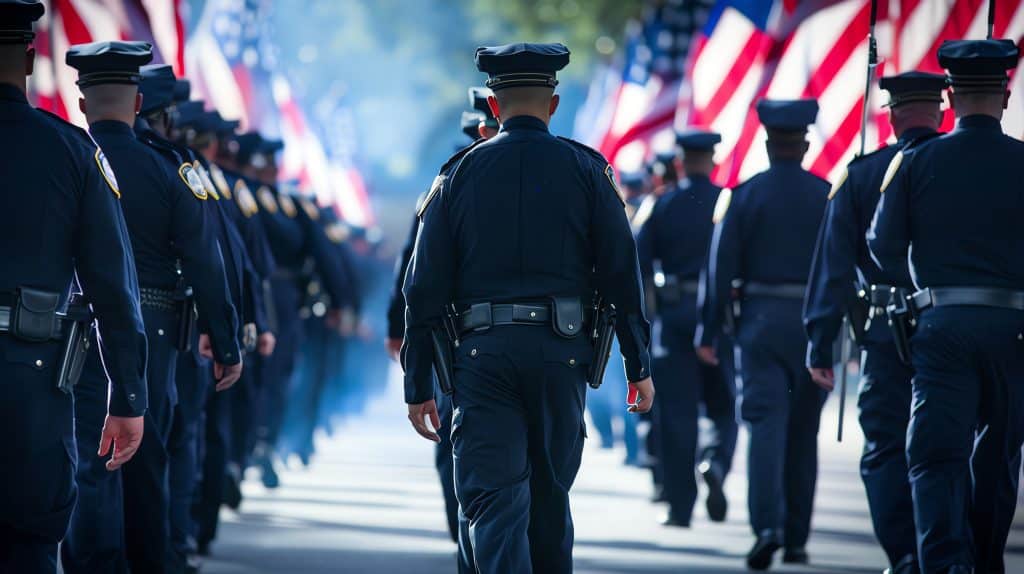Police reform in America: Key proposals and community safety effects

Police reform in America focuses on key proposals like accountability, de-escalation, and community policing, aiming to enhance safety and trust between law enforcement and citizens by addressing systemic issues and fostering collaborative relationships.
The conversation around police reform in America, what are the key proposals and their potential effects on community safety has intensified significantly, reflecting a societal push for more equitable and effective law enforcement.
It’s a complex issue, deeply rooted in historical contexts and evolving societal needs, prompting a wide array of proposed changes intended to reshape policing practices and improve public trust.
Understanding the urgent need for Police reform in America
The ongoing discourse surrounding Police reform in America is not merely theoretical; it emerges from profound societal experiences and growing demands for justice and accountability.
Communities across the nation have voiced concerns regarding incidents of excessive force, racial bias, and a perceived lack of transparency, leading to a critical examination of current policing methods and their impact on public safety.
This collective outcry underscores a fundamental desire for law enforcement agencies to better serve and protect all citizens equitably.
Historical grievances, often intersecting with contemporary events, have fueled a widespread recognition that the existing framework of policing requires significant adjustments.
The disparities in how justice is administered and how communities, particularly those of color, interact with police have highlighted systemic issues.
These issues not only erode trust but can also inadvertently exacerbate community tensions, underscoring the urgent necessity for comprehensive reform initiatives.
Root causes of disillusionment with policing
Several factors contribute to the public’s disillusionment with traditional policing. These include:
- Historical patterns of racial bias and discrimination that have disproportionately affected minority communities.
- Incidents of police brutality and excessive force, often amplified by social media, leading to calls for greater accountability.
- A “tough on crime” approach that sometimes prioritizes arrests and convictions over community engagement and preventative measures.
Addressing these root causes is paramount to rebuilding trust and ensuring that police departments genuinely serve as a force for good within their communities.
It demands a holistic approach that acknowledges past wrongs while actively working towards a more just and equitable future. Furthermore, the militarization of police forces, evident in their equipment and tactics, has also been a point of contention.
Critics argue that this approach can create an adversarial relationship between officers and the public, shifting the perception of police from community protectors to occupying forces.
Such dynamics highlight the complexity of the Police reform in America debate, where both perceived and actual changes in policing strategies hold significant weight in public opinion and safety outcomes.
Key proposals for enhancing police accountability
Central to the dialogue on Police reform in America are proposals aimed at strengthening accountability mechanisms.
The objective is to ensure that officers who engage in misconduct are held responsible, thereby deterring future transgressions and rebuilding public confidence in law enforcement.
These accountability measures are not punitive in nature but rather serve as a foundational element for fostering trust and ensuring justice. It’s about creating a system where integrity and adherence to ethical standards are consistently upheld.
One primary area of focus is the Police reform in America of qualified immunity, a legal doctrine that often shields government officials, including police officers, from liability in civil lawsuits unless their conduct violates clearly established statutory or constitutional rights.
Critics argue that qualified immunity makes it excessively difficult to sue officers for misconduct, thereby reducing incentives for responsible behavior and making it harder for victims to seek redress.
Reforming or eliminating this doctrine is seen by many as a crucial step towards greater accountability, allowing more swift and direct legal recourse against officers who abuse their authority.
Mechanisms for external oversight and transparency
Beyond qualified immunity, several other mechanisms are being proposed to boost police accountability:
- Civilian oversight boards: independent bodies composed of community members designed to review police conduct, investigate complaints, and provide recommendations on policy and discipline. This enhances transparency and provides a direct avenue for community input.
- Body cameras and dashcams: mandating the use of body-worn cameras and vehicle dashcams to record interactions between officers and the public. These recordings can serve as objective evidence in investigations of misconduct, offering unbiased perspectives on incidents.
- National misconduct registries: creating a national database to track officers with histories of misconduct, including those terminated or resigned due to disciplinary issues. This aims to prevent officers from simply moving to another department without their past being known.
Each of these proposals seeks to create systems that are less susceptible to internal biases and more responsive to public expectations of justice.
The implementation of such measures is expected to not only deter misconduct but also to improve investigations of alleged wrongdoing, ensuring fair outcomes for both officers and the public.
Moreover, enhancing the investigative powers of internal affairs units and ensuring their independence from departmental leadership is another critical component of accountability Police reform in America.
This involves providing these units with adequate resources and authority to thoroughly investigate complaints, free from undue influence, ultimately bolstering the integrity of the disciplinary process.
The commitment to robust internal and external oversight is what truly underpins a responsive and responsible law enforcement agency.

Rethinking police training and de-escalation tactics
A significant component of Police reform in America efforts centers on overhauling police training programs, with a particular emphasis on de-escalation tactics and implicit bias recognition.
The traditional model of police training often prioritizes physical control and tactical responses, which, while necessary in certain high-risk situations, may inadvertently contribute to situations escalating unnecessarily.
The goal of this reform is to equip officers with a broader range of skills that promote non-confrontational conflict resolution, ultimately reducing the incidence of force and improving peaceful outcomes.
De-escalation training teaches officers how to verbally and non-verbally communicate with individuals in crisis or agitated states, aiming to reduce tension and gain voluntary compliance without resorting to physical force.
This approach emphasizes active listening, empathy, and patience, enabling officers to better understand and respond to the underlying causes of a situation.
The shift towards de-escalation is not about diminishing an officer’s authority but rather enhancing their ability to resolve conflicts safely for all parties involved.
Integrating implicit bias and mental health training
New training paradigms also focus on two critical areas:
- Implicit bias training: designed to help officers recognize and mitigate unconscious biases that may influence their perceptions and interactions, particularly those related to race, ethnicity, and socioeconomic status. This aims to foster more equitable policing practices.
- Mental health response training: equipping officers with the knowledge and skills to respond effectively to individuals experiencing mental health crises. This often involves collaborating with mental health professionals to divert individuals away from the criminal justice system and towards appropriate care, reducing the likelihood of confrontational encounters.
Implementing these advanced training modules is seen as crucial for addressing systemic issues within policing and ensuring that officers are better prepared to handle the diverse and often complex situations they encounter in their communities.
It’s a proactive step towards building a police force that is not only effective in enforcing laws but also compassionate and culturally competent.
Furthermore, an increased emphasis on scenario-based training, which simulates real-life situations, allows officers to practice de-escalation and other critical decision-making skills in a controlled environment.
This practical application of learned techniques helps reinforce the training and prepares officers for the nuances of community interactions.
These reformed training methodologies are not merely theoretical; they represent a tangible shift towards a more humane and effective approach to maintaining public order and safety.
The role of community policing and alternative response models
Community policing represents a philosophical shift in law enforcement, advocating for strong, collaborative relationships between police departments and the communities they serve.
This approach moves beyond traditional crime suppression to embrace proactive engagement, problem-solving, and partnership building.
By fostering trust and communication, community policing aims to prevent crime more effectively, improve quality of life, and ensure that police services are tailored to the specific needs and priorities of each community.
It acknowledges that public safety is a shared responsibility, best achieved when citizens and officers work together.
The core tenets of community policing involve officers becoming integral parts of the neighborhoods they patrol, understanding local nuances, and building rapport with residents.
This can include regular foot patrols, community meetings, youth engagement programs, and collaborative initiatives to address local issues.
Such approaches often lead to greater information sharing, increased willingness from residents to report crimes, and a sense of shared ownership in maintaining peace and order. It shifts the focus from reactive enforcement to proactive community betterment.
Exploring alternative response models
In parallel with community policing, there’s growing interest in alternative response models, particularly for non-violent calls for service.
These models involve dispatching non-law enforcement professionals, such as mental health specialists, social workers, or paramedics, to respond to situations traditionally handled by the police.
The rationale is that many calls, including those related to homelessness, substance abuse, or mental health crises, may be better addressed by professionals with expertise in those specific areas, leading to more appropriate and less confrontational outcomes.
- Crisis intervention teams (CIT): programs where select police officers receive specialized training in de-escalating situations involving individuals with mental illness and connecting them to appropriate services, often working in partnership with mental health professionals.
- Non-police emergency response units: deploying teams composed solely of social workers, paramedics, or mental health experts to respond to calls that do not involve imminent threats of violence. This reduces police presence in situations where it might exacerbate tensions.
- Restorative justice practices: an approach that focuses on repairing harm caused by crime through cooperative processes involving victims, offenders, and community members, aiming for reconciliation and reintegration rather lists than purely punitive measures.
These alternative response models aim to free up police resources for more serious crimes while simultaneously providing more effective and compassionate care for vulnerable populations.
By strategically reallocating responsibilities, communities can achieve better outcomes in both public safety and public health, moving towards a more diversified and specialized approach to emergency response.
The implementation of these diverse models necessitates a comprehensive review of existing emergency response systems and a commitment to interagency collaboration.
It’s about building a robust network of services that can holistically address the myriad challenges faced by communities, recognizing that not every problem requires a law enforcement solution.
This adaptive strategy not only enhances safety but also fosters a more integrated and supportive community environment.
Addressing systemic racism within law enforcement
The imperative to address systemic racism within law enforcement is a critical, overarching theme in the discourse around Police reform in America.
This goes beyond individual instances of bias to examine the policies, practices, and cultural norms that may inadvertently perpetuate racial disparities and discrimination within police departments.
Acknowledging and actively confronting systemic racism is essential for achieving truly equitable and just policing outcomes for all members of society. It demands a deep and honest introspection within institutions and a commitment to fundamental change.
Systemic racism in policing manifests in various ways, including disparate arrest rates for similar offenses, racial profiling, and the disproportionate use of force against minority individuals.
These patterns are not necessarily indicative of individual officers’ personal prejudices but often reflect ingrained practices and cultural biases that have developed over time within the institution.
Unpacking these historical and ongoing issues is the first step toward dismantling them and laying the groundwork for a more just system.
Strategies for achieving racial equity in policing
Several strategies are proposed to address systemic racism:
- Data collection and analysis: mandating comprehensive data collection on police stops, arrests, uses of force, and citizen complaints, disaggregated by race, ethnicity, and other demographics. This data is crucial for identifying patterns of disparity and informing policy changes.
- Diversifying police forces: actively recruiting and retaining officers who reflect the racial and ethnic diversity of the communities they serve. A more representative force can foster greater understanding and trust between police and residents.
- Reviewing and revising departmental policies: examining internal policies for hidden biases and impacts that disproportionately affect minority groups, particularly policies related to patrol strategies, disciplinary actions, and promotion criteria.
Implementing these strategies requires a sustained commitment from police leadership, policymakers, and community stakeholders.
It’s a long-term endeavor that involves continuous dialogue, policy adjustments, and cultural transformation within law enforcement agencies.
The goal is to move beyond mere compliance to fostering an environment where fairness and equity are deeply embedded in every aspect of policing.
Furthermore, engaging directly with historically marginalized communities to understand their experiences and perspectives is vital.
This participatory approach ensures that Police reform in America reform efforts are informed by those most affected by systemic issues, leading to more effective and culturally sensitive solutions.
Addressing systemic racism is not just about changing rules; it’s about fundamentally reshaping relationships and perceptions to build a police force that genuinely protects and serves everyone, without prejudice.
Potential effects on community safety and trust
The success of Police reform in America measures is ultimately measured by their potential effects on community safety and the restoration of public trust.
When implemented thoughtfully and comprehensively, these reforms are expected to yield tangible benefits that create safer environments and strengthen the relationship between law enforcement and citizens.
The desired outcome is a policing paradigm where security is not merely about crime rates but also about the subjective sense of safety and fairness experienced by all community members. This holistic view recognizes that trust is a powerful determinant of public safety.
A primary effect of successful reform is an anticipated reduction in instances of police misconduct and excessive force.
By enhancing accountability, improving training, and implementing robust oversight, police departments can foster a culture where officers are more judicious in their actions and more respectful of civil liberties.
This, in turn, can lead to fewer negative interactions between police and the public, thereby reducing community grievances and tensions. When police act with integrity and restraint, citizens are more likely to view them as partners rather than adversaries.
Building bridges and fostering collaboration
The reforms are also expected to pave the way for numerous positive impacts:
- Increased public trust and cooperation: as police become more accountable and community-oriented, residents are more likely to trust law enforcement and cooperate in investigations, leading to more arrests and successful prosecutions of serious crimes. This virtuous cycle enhances overall safety.
- Reduced crime rates through prevention: a police force deeply integrated into the community can leverage local knowledge and partnerships to address the root causes of crime proactively, rather than solely reacting to incidents. This preventative approach can lead to sustainable reductions in crime.
- Enhanced officer safety and morale: when officers are well-trained, supported by their communities, and work within a system perceived as fair, their morale and overall safety can improve. A less adversarial environment means fewer confrontational incidents and greater job satisfaction.
The collective effect of these changes is a fundamental shift towards a policing model that is both effective and legitimate in the eyes of the public. It moves beyond a narrow focus on criminal apprehension to embrace a broader role in community well-being and justice.
This emphasis on trust-building is crucial because a community that trusts its police is a community more willing to engage in collaborative efforts to ensure its own safety and prosperity.
Ultimately, the success of Police reform in America hinges on its ability to transform the dynamic between law enforcement and the public from one often characterized by tension to one founded on mutual respect and shared goals.
The realization of a truly safe community depends not only on the absence of crime but also on the omnipresence of justice and equity in all interactions with authority. This vision of reform is ambitious yet undeniably critical for the future of American society.
Challenges and resistance to Police reform in America
Despite the compelling arguments for Police reform in America and the evident societal demand for change, the path to implementation is fraught with significant challenges and often met with considerable resistance.
These obstacles are multifaceted, ranging from ingrained institutional cultures to political and financial hurdles, making comprehensive reform a complex and protracted process.
Understanding these barriers is crucial for developing strategies that can effectively overcome them and ensure meaningful change. One of the primary sources of resistance stems from police unions and professional associations.
While these organizations play a vital role in protecting officers’ rights and ensuring fair working conditions, they often oppose reforms that they perceive as undermining officer safety, morale, or autonomy.
Collective bargaining agreements, negotiated with unions, can sometimes embed provisions that make it difficult to discipline officers for misconduct or implement new training mandates, thereby creating formidable institutional roadblocks to reform.
Navigating these union agreements requires careful negotiation and a clear articulation of mutual benefits.
Overcoming systemic and financial barriers
Other significant challenges include:
- Ingrained departmental cultures: police departments often possess strong internal cultures that can be resistant to change, particularly when proposed reforms challenge long-standing practices or perceived traditions. Overcoming this requires visionary leadership and consistent reinforcement of new values.
- Political will and legislative inertia: implementing sweeping reforms often necessitates legislative action at local, state, and federal levels. However, political divisiveness, competing priorities, and a lack of sustained political will can lead to legislative inertia, stalling progress.
- Financial constraints: many proposed reforms, such as enhanced training programs, technology upgrades (e.g., body cameras), and alternative response models, require substantial financial investment. Budgetary limitations can be a significant barrier for municipalities, especially smaller ones.
Addressing these challenges requires a concerted and collaborative effort involving policymakers, community leaders, law enforcement agencies, and the public.
It demands not just the articulation of reform ideas but also the strategic planning and resource allocation necessary to bring them to fruition.
The complexity of these challenges means that Police reform in America is rarely a quick fix but rather an ongoing commitment to continuous improvement and adaptation.
Moreover, the narrative around Police reform in America can become highly politicized, with differing viewpoints often framing the debate in starkly opposing terms.
This polarization can hinder constructive dialogue and compromise, making it difficult to forge consensus on even broadly supported measures.
Overcoming this requires fostering environments for open, respectful discussion, focused on common goals of public safety and justice, rather than entrenched ideological positions.
Ultimately, sustained pressure from informed citizen groups remains a vital catalyst for driving reform forward against these powerful forces of resistance.
| Key Proposal | Brief Description |
|---|---|
| ⚖️ Enhanced Accountability | Focuses on measures like civilian oversight and reform of qualified immunity to ensure officers are held responsible for misconduct. |
| 🤝 Community Policing | Emphasizes building strong relationships between police and residents to foster trust and collaborative crime prevention. |
| 🧠 Improved Training | Reforms training to prioritize de-escalation, implicit bias recognition, and appropriate responses to mental health crises. |
| 💬 Alternative Responses | Diverting non-violent calls for service to non-law enforcement professionals like social workers or mental health specialists. |
Frequently Asked Questions (FAQ) about Police reform in America
Qualified immunity is a legal doctrine that protects government officials, including police officers, from liability in civil lawsuits unless their conduct violates clearly established statutory or constitutional rights. It’s debated in Police reform in America because critics argue it makes it too difficult to sue officers for misconduct, thereby hindering accountability and making it harder for victims to seek justice for alleged abuses of power.
Community policing enhances public safety by fostering collaborative relationships and trust between police and residents. This approach leads to increased information sharing, greater cooperation in crime prevention, and a deeper understanding of local issues. When citizens view police as partners, they are more likely to report crimes and engage in community safety initiatives, leading to more effective and sustainable safety outcomes for everyone.
De-escalation tactics are communication and behavioral strategies designed to reduce tension and resolve conflicts without the need for physical force. They are crucial in police training because they equip officers with skills to manage agitated individuals, understand underlying issues, and achieve peaceful resolutions. This reduces injuries to both officers and citizens, improves public trust, and promotes more humane and effective law enforcement encounters.
Yes, Police reform in America can address systemic racism by implementing comprehensive strategies such as mandatory data collection on racial disparities, diversifying police forces, and rigorously reviewing and revising departmental policies for hidden biases. While a complex and ongoing process, these reforms aim to dismantle institutional practices that perpetuate unequal treatment, fostering a more equitable and just policing system for all communities and building long-term trust.
Alternative response models involve deploying non-law enforcement professionals, like mental health specialists or social workers, to respond to non-violent calls such as homelessness or mental health crises. Benefits include providing more appropriate, specialized care, diverting individuals from the criminal justice system, and freeing up police resources for more serious crimes. This leads to better outcomes for vulnerable populations and a more efficient allocation of public safety resources within communities.





